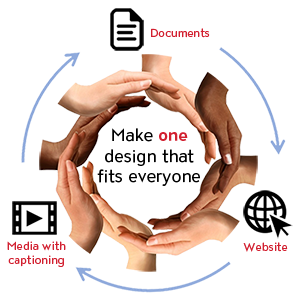CSUN Syllabus Policy
To better inform students about the requirements, content, and methodology of the university’s curricula, all faculty teaching classes will distribute a written syllabus to each student in the class and/or post it online no later than the first class meeting. Visit CSUN Syllabus Policy and Course Accessibility Checklist.
Q: Do you have sample language to include Canvas Ally in a syllabus?
Canvas Ally is a university initiative to help make course materials more accessible to all students. Next to each file in Canvas is a small arrow icon that opens a menu with three options. The third option is Alternative Formats. You will be able to download different formats of the file, which may include a PDF, browser (HTML), reader (ePub) or audio (MP3) files. For more information, please visit www.csun.edu/ally.
Video Presentation in Panopto

- Use your CSUN username and password to watch Accessible Syllabus in the Panopto.
- Watch other UDC Training Videos
Presentation Slides

- Creating an Accessible Syllabus (Windows, pdf)

- Creating an Accessible Syllabus (Mac, pdf)

- Google Docs Accessibility
- Word Designing with Accessibility
Tables
Video Tutorials
Video Credit: The University of Alabama, Technology Accessibility - Creating Accessible Word Documents (total length 54:42 mins)
Creating Accessible Word Documents Segmented Videos
- What is Accessibility Checker (start time: 2:42)
- Built-in Styles and Templates (start time: 7:54)
- Easy to Navigate by Section Headings (start time: 10:30)
- Navigation Pane (start time: 13:54)
- Heading Styles (start time: 15:05)
- Update to Match Selection (start time: 18:52)
- Table of Contents (start time: 20:20)
- Bullets and Numbers List (start time: 21:59)
- Hyperlinks (start time: 24:01)
- Images Alternative Text (Alt Text) (start time: 29:26)
- Color Contrast (start time: 37:23)
- Converting to PDFs and Tags (start time: 42:17)
- Avoid Print to PDF (start time: 48:30)
- PDF Accessibility Checker (start time: 49:34)
| Format | Tutorials |
|---|---|
| Word Document or save as PDF can provide a universal approach to creating an accessible syllabus. |
Canvas Digital Syllabus |
|
| Content Type | Description |
|---|---|
Headings |
|
Styles |
|
Images |
|
Color |
|
Links |
|
Tables |
|
Multimedia |
|
Reading Order |
|
Accessibility Checker | Word Document
Adobe Acrobat
Canvas Digital Syllabus
Canvas Ally
|
Templates
- CSUN, Universal Design Center: Accessible Syllabus Template (Word doc)
- San Diego State University: Accessible Syllabus Template
- San Jose State University: Accessible Syllabus Template
Conducting Accessibility Evaluations
- Course Accessibility Checklist
- Basic Evaluations
- MS Office Evaluations
- Adobe Acrobat Evaluations
- Multimedia Evaluations
Resources
- Canvas Ally
- Captioning
- Describing images
- Readability
- Color contrast
- Colour Contrast Analyzer
- Comprehensive Link Text
- Perspectives Video
"Universal Design" means design for everyone
- How to create accessible web content?
- How to create accessible documents content?
- Online & Self-Paced Accessibility Modules are now available in the Canvas learning management system. Enter your CSUN user ID and password to self-enroll Accessibility Modules with Canvas course.














